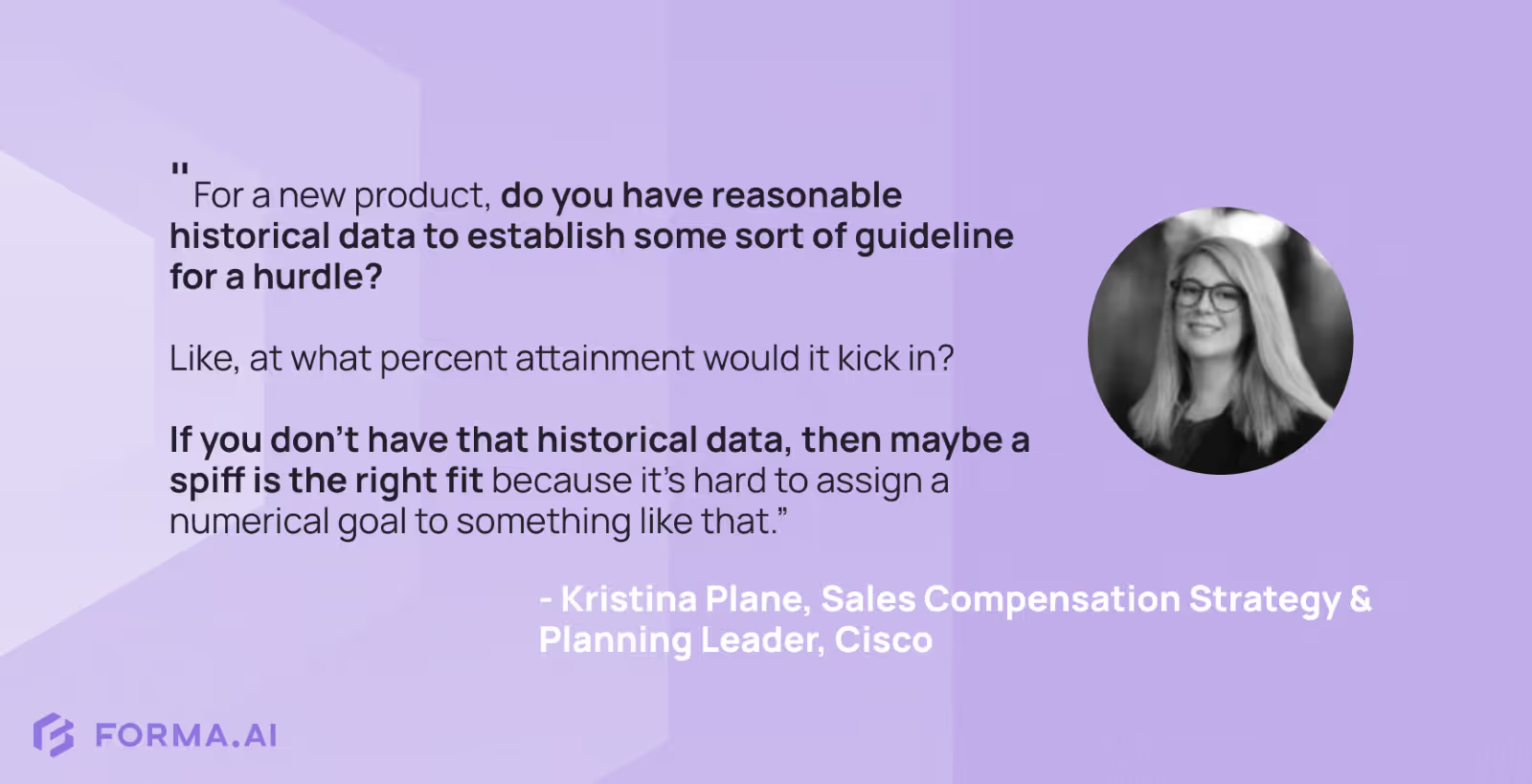.avif)
Sales compensation nightmares: What to do when sales incentives backfire
.avif)
Sales compensation nightmares: What to do when sales incentives backfire
Learn from sales performance management experts from Cisco, Unity, and Databricks at NUDGE '24 as they share insights on avoiding sales incentive pitfalls, from unfair quotas to gaming tactics.
.avif)
Sales compensation nightmares: What to do when sales incentives backfire
Learn from sales performance management experts from Cisco, Unity, and Databricks at NUDGE '24 as they share insights on avoiding sales incentive pitfalls, from unfair quotas to gaming tactics.
.avif)
Sales compensation nightmares: What to do when sales incentives backfire
Learn from sales performance management experts from Cisco, Unity, and Databricks at NUDGE '24 as they share insights on avoiding sales incentive pitfalls, from unfair quotas to gaming tactics.
Sales compensation nightmares: What to do when sales incentives backfire
Learn from sales performance management experts from Cisco, Unity, and Databricks at NUDGE '24 as they share insights on avoiding sales incentive pitfalls, from unfair quotas to gaming tactics.
.avif)
Sales incentives are powerful motivators but can lead to unfortunate outcomes if they're not carefully designed or monitored.
At our virtual conference NUDGE '24, we invited industry leaders Kristina Plane, Pauline Xu, and Vince DaCosta of Cisco, Unity, and Databricks, respectively—to critique theoretical scenarios of when incentivizing sellers went awry.
And they did not disappoint.
From unfair quotas and territories to rep-exploited plans with loopholes, our experts had recommendations for how they'd navigate everything. All with the nuance you'd expect from experts with dozens of combined years of experience.
Most of their advice—fortunately—details how to proactively avoid nightmare scenarios and stay two steps ahead.
You can watch the full session on-demand here, or we've summarized the key takeaways below...

Nightmare 1: A sales incentive leads to a decline in core product sales
At the very start of the session, we learned how our sales compensation experts tackle multi-product bags to better balance several sales objectives at once.
In this first theoretical compensation scenario:
A company wanted to promote a net new product with low customer awareness (requiring a high degree of education and effort from sales).
- The rebuilt comp plan allocated a significant amount of weighting in terms of the OTE for the reps.
- This resulted in a threefold increase in sales for the targeted product, but also decreased core product sales (which represented a significant amount of the company's annual revenue).
Here's our SPM experts on this scenario:
The takeaways:
To prevent sales teams from neglecting core products, you can:
- Implement a hurdle system where a minimum percentage of core product sales must be achieved on one product before commissions for other products unlock. (I.e. you need to hit a min of 75% on product A before commission opens for product B.)
- Or try a (simpler) accelerator or modifier on the new product. If adding a hurdle to your comp plan is too complex, you could do something similar to a spiff that's built into the comp plan to give a multiplier or additional percentage at a certain level of attainment whenever the new product is sold successfully.
Ultimately, the choice you make between the two options above is largely dependent on the lifecycle or stage of the product.
As Kristina shared:

Nightmare 2: A sales comp plan changes to favor net new growth, but amounts in customers feeling pressured
In this scenario, a hypothetical company paid reps based on a book of business they built up (and hadn't changed the comp plan in some time).
As such, reps weren't totally incentivized to grow and became complacent.
The business revamped the compensation plan, allocating most variable pay towards net new business. But, just a year after rollout, while net new customer sales grew, many existing customers reporting feeling pressured (which led to an increase in returns and support requests).
So, how can you promote a healthy sales culture, all while balancing aggressive sales targets?
As Vince shared:

The proposed solutions:
- First, balance and broaden your focus to lifetime customer value instead of just short-term wins with your comp plan. You can be clear that when customers are ready to buy new products, you'll be there and want to support this, but be sure to communicate that the sales team can't prioritize net new deals at the expense of existing business.
- Consider whether you have an equal focus on your existing, baseline customers with enablement and (equally) a customer success team. I.e. is the sales team a true hunting organization with the capacity to focus on just net new business? Wherein there's also a renewals team that harbors existing customers?
- If sellers do own everything from net new through to renewals, aim to strike a delicate balance: This may require different weightings. I.e. Maybe the net new business is weighted heavier than the renewal business? Maybe the net new business has a higher accelerator on it than renewals?
- Have an enablement rollout plan where sellers learn how to help existing customers for the long-game post-sale. Share the vision and importance of the growth to the business, but also about the expectation for meeting customers where they are, and making them feel valued as a baseline customer.
Nightmare 3: You discover reps gaming the plan
As a compensation professional, you'll inevitably come up against reps strategically engineering their deals for personal advantage.
You might not come across the entirely unethical (i.e. cancelling contracts to resell the same product or service to the same customer), but there are some gaming loopholes that are more common, including:
- Splitting single deals into multiple, smaller ones to meet several sales targets or quotas.
- Pushing to close deals early or late in evaluation periods to maximize accelerators (potentially neglecting the quality or suitability for the customer).
- Using excessive discounting to close quicker or boost your volume.
You'll often discover gaming through commission disputes, or comp assurance audit processes. Massive outliers will typically sound alarm bells, or you'll notice unideal behaviors behind a deal's execution.
So, how do you design plans that are fair, and difficult to exploit?
As Victor shared, reps may try to figure out the quota setting process, specific to what data is being collected, when, and how, to control their current pipeline or forecasting to close the deals before or after a certain period to set them up for success the following fiscal year.
Besides including enough validation checks and reviews before administering compensation, our panelists agreed, tightening your governance is your best bet in this scenario.
The proposed solutions:
- Proactively set expectations early with clear terms and conditions defining accepted behaviors. Your documentation should account for what-if scenarios, including things like quota relief (re: what happens when there are contract cancellations, a customer goes out of business, etc.).
- Within your terms and conditions, provide a framework for handling disputes, and outline the businesses protective measures. I.e. should attainment skyrocket, will the business consume that additional expense?
- Document your compensation audit process or evaluation process for high attainment. I.e. if a rep pulls a deal in from a future fiscal, determine if it'll be factored into the goal. It may involve getting involved in comp assurance, or an audit process or a decelerated rate calculation.
Nightmare 4: unfair, unbalanced territories and quotas
For many in sales compensation, few things ignite more heated conversations faster than unfair territories and unrealistic quotas.
The ripple effect is brutal—disheartened reps, missed targets, and a flood of compensation disputes that threaten to derail the entire sales machine. It can spiral out of control.
In our session we split this into two parts. First, we outlined territory bias, where we tend to see:
- Territories that don't adequately balance customer potential and sales opportunity,
- Plans and territories that reward long-tenured reps to build their business and coast and,
- Competition overlap between territories.
On the quota side of the equation, we see pains like:
- Quotas set based off historical growth (but don't account for seasonality), and
- One-size-fits-all quotas that don't factor in nuances.
We asked our panelists to weigh in on best practices for keeping territories and quotas balanced.
The biggest takeaways?
- Examine historical performance data to inform territory assignments and approach territory and quota setting as a mathematical exercise. The key is proactive monitoring during the territory setting process: regularly assess bookings potential, and rely on historical coverage data (did you have adequate coverage somewhere in past fiscals?). Consider how much coverage makes sense related to the current needs of the business and what's the booking strategy for these areas?
- Work directly with your sales leaders who know their business best to dive into those conversations as you run coverage-setting activities. Ask tough questions, like whether and why you may have headcount allocated to territories where there's not a great deal of potential.
- Additionally, develop strong relationships with the finance team to ensure that—whether top down or bottom up—the proposal for the territories and quotas shows a reasonable result for the goals of the business.
- Further, evaluate whether sales targets are achievable based on market potential. A truly proactive approach helps optimize coverage and ensures territories are neither under nor over-served. Really get into the needs of the business, and determine your go to market strategy.
- Have some defined rules of engagement for territories. This could be for handoffs from an account (from hunter to account manager), all the way through to partnering on a deal for splits. This can help avoid a 'Wild West' approach with guidelines.
On ensuring transparency and fairness in quota setting, the group emphasized simulating potential outcomes using historical data in your SPM solution.
- Determine how your organization wants to handle quota adjustments. I.e. do you want to put in a a minimum threshold by an individual, by a territory book of business? What is justifiable within the reps control? What is outside the reps control? Proactive planning here will allow you to develop a playbook.
- Be as transparent as you can in comp plan rollout sessions around the factors that go into goal setting and how you arrive at the numbers. Partner with and empower the sales leaders to ensure they're coaching and helping their teams understand how the targets were derived and secure buy-in for the logic and philosophy together.
- Create proactive documents for quota relief /various scenarios.
Ultimately, using historical data to run projected scenarios with your sales leaders involved can really help you demonstrate fairness and predictability to sellers in achieving their targets, as well as foster trust and alignment within the sales team (they'll better understand how you got to your well-thought-out figures).



.png)




